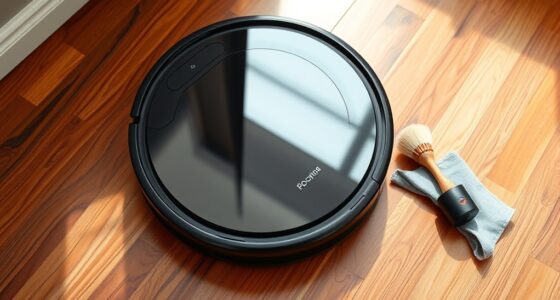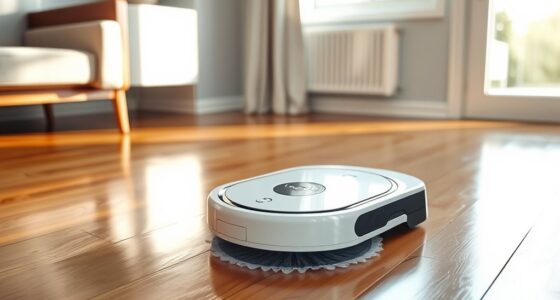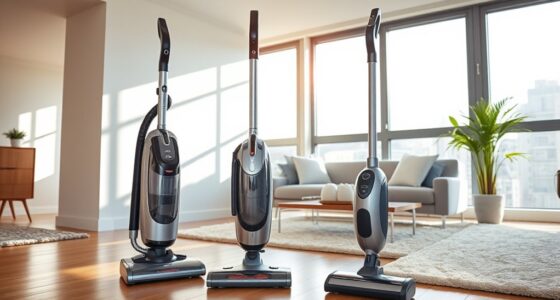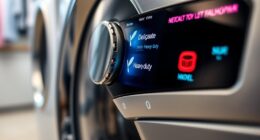If you’re looking for a vacuum that traps more dust and allergens, bagged models with HEPA filters are your best choice. They contain dust securely within sealed bags, reducing the chance of dust escaping during disposal, and are especially good if you have allergies. Bagless vacuums can trap dust effectively too, but they often need frequent filter maintenance to stay efficient. To discover which type suits your needs best, you’ll want to explore the key differences further.
Key Takeaways
- Bagged vacuums with HEPA filters typically trap more dust and allergens, especially for allergy sufferers.
- Bagless models can trap comparable dust levels if equipped with high-quality, well-maintained filters.
- Sealed bags prevent dust escape during disposal, offering superior dust containment compared to bagless canisters.
- Proper filter maintenance in both types ensures consistent dust trapping efficiency over time.
- Overall, bagged vacuums generally provide better dust and allergen containment than bagless models.
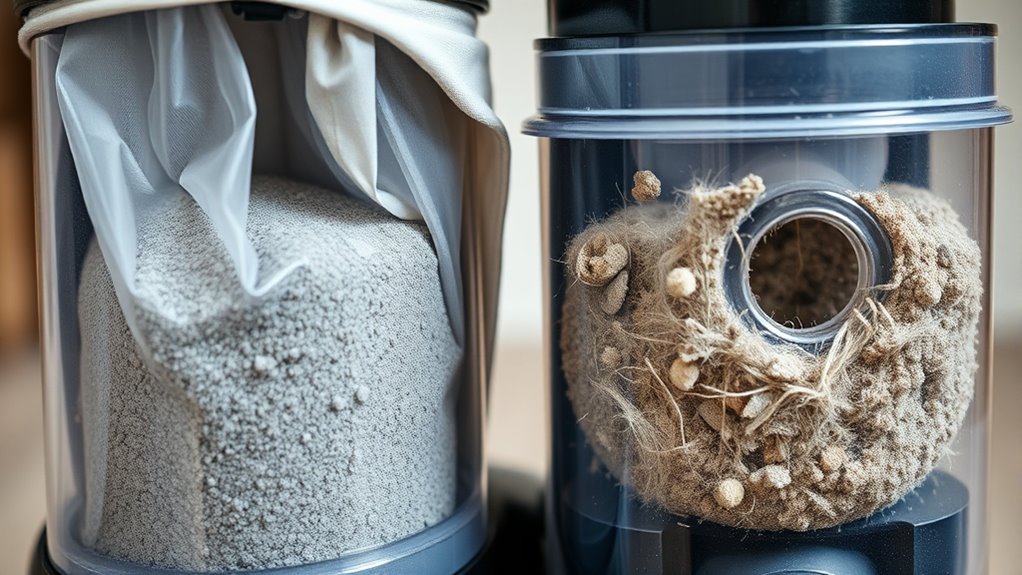
Are you struggling to decide between a bagged and a bagless vacuum? It’s a common dilemma, especially when considering how well each type traps dust and allergens. Bagged vacuums often feature HEPA filters, which are designed to trap tiny particles like pollen, pet dander, and dust mites, making them ideal for allergy sufferers. These filters work by trapping allergens inside the bag, preventing them from being released back into the air during vacuuming. Many bagged models also offer cordless convenience, giving you freedom of movement without the hassle of cords tangling or limiting your cleaning area. This combination makes them particularly appealing if you want a tidy, efficient cleaning experience that minimizes airborne allergens.
Bagged vacuums with HEPA filters effectively trap dust and allergens, ideal for allergy sufferers seeking a tidy, allergen-reducing clean.
On the other hand, bagless vacuums have gained popularity because of their ease of use and cost-effectiveness. You can see exactly how much dirt you’ve collected, which is satisfying and helps you know when to empty the canister. They typically use cyclonic technology to separate dust from the airflow, but whether they trap as many fine particles as bagged models depends on the presence of advanced filters. Some bagless vacuums come equipped with HEPA filters, which enhance their dust-trapping capabilities. This is vital if you’re concerned about dust escaping back into the environment. However, because the dust is stored in a canister that you manually empty, there’s a risk of exposure to allergens when you do so. Proper maintenance of filters and regular emptying can mitigate this, but it’s a factor to weigh if you want to trap as much dust as possible.
When comparing dust-trapping efficiency, bagged vacuums tend to be better at containing fine particles due to their sealed bags and filters, which prevent dust from escaping during disposal. They often require less frequent filter cleaning since the bag acts as a primary barrier. Conversely, bagless models might need more frequent filter maintenance to keep dust levels low, especially if you’re dealing with a lot of hair or fine debris. The choice also hinges on your lifestyle; if you value cordless convenience, a bagged vacuum with a HEPA filter can provide a seamless, allergen-reducing experience. Meanwhile, if you prefer seeing your dirt and saving money on replacement bags, a bagless model with high-quality filters might suit you better.
Ultimately, your decision depends on how much dust you need to trap, your allergy concerns, and your cleaning preferences. Both types can be effective, but understanding their dust-trapping capabilities and convenience features will help you pick the one that keeps your home cleaner and healthier. Additionally, choosing a vacuum with proper filter maintenance can significantly improve dust containment over time.
Frequently Asked Questions
Which Vacuum Type Is Better for Allergy Sufferers?
If you’re an allergy sufferer, you should prioritize air quality and dust containment. Bagged vacuums are better because they trap more dust and allergens inside, reducing their escape into the air. Bagless models often release more dust when emptying, which can trigger allergies. So, choose a high-quality bagged vacuum to keep your indoor air cleaner and minimize allergy symptoms effectively.
Are Bagless Vacuums More Cost-Effective Over Time?
You might find that bagless vacuums are more cost-effective over time because they eliminate the need for replacement bags, reducing ongoing costs. However, consider maintenance costs, as emptying and cleaning filters can add up. A clear cost comparison shows that while bagless models save money on consumables, you should also factor in potential filter replacements. Overall, your choice depends on maintenance preferences and long-term budget considerations.
How Often Should Filters Be Replaced in Each Vacuum Type?
You should replace filters regularly, or you’ll be fighting a losing battle against dust! In bagless vacuums, filter lifespan varies but typically demands replacement every 3 to 6 months, depending on usage. Bagged vacuums usually need less frequent changes, about once a year, since the filter is less exposed. Keep up with replacement frequency to guarantee peak suction and keep your home dust-free!
Do Bagged Vacuums Have Better Suction Power?
You might find that bagged vacuums often provide better suction power because they maintain more consistent airflow efficiency over time. The sealed bag design helps prevent clogging, ensuring steady suction and airflow. In contrast, bagless models can lose suction as their filters or canisters fill up. So, if you want reliable suction consistency, a bagged vacuum generally performs better and traps dust more effectively.
Which Vacuum Type Is More Environmentally Friendly?
When choosing a vacuum, you wonder which type is more environmentally friendly. You should consider recycling capabilities and energy consumption. Bagged vacuums often use replaceable bags that are recyclable, reducing waste. They also tend to consume less energy during operation. On the other hand, bagless models save on bag waste but may require more frequent filter replacements and higher energy use. Ultimately, your choice depends on your eco priorities.
Conclusion
So, if you’re seeking a cleaner, clearer choice, consider your cleaning needs carefully. Bagged vacuums trap more dust and keep your space spotless, while bagless models offer convenience and cost savings. Decide what suits your style—simplicity or sustainability—and steer toward the vacuum that suits your space. Whether you prefer the tidy trap of a bagged model or the breezy benefit of bagless, your dust dilemma is about to be solved. Happy vacuuming!


